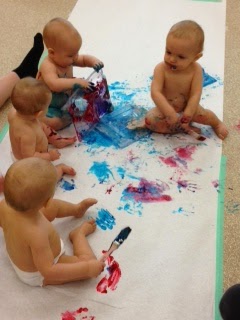 |
| Babies exploring non-toxic paint, together. |
The idea of messy play is so important to us at the YCCF that we put it into our policy manual, so families understand that their children are likely to get paint, water, mud, soap, play dough or glue on their clothing during the day.
Why do we think it's so important? We know that children learn best when they can engage all of their senses in their exploration of the world. And materials with interesting textures are the most engaging of all. Materials that children love include paint (especially finger paint), shaving cream, mud, water, uncooked rice, dried beans, and various recipes for play dough, "goop" and "gak." There's even one we call "ooblek!"
Sensory play uses big and small muscles. When children explore with these materials, they use not only the small muscles of their fingers and hands, but also the larger muscles of their arms as they move, squish, dump and pile the materials. And when the sensory experience involves a rain puddle, mud puddle, or sandbox, their whole body gets involved! There's also something extremely soothing about sensory experiences-- both for adults and young children. Letting a big handful of dry rice fall through your fingers is inherently attractive to us. It just feels good. Petting a soft, silky cat calms us. When teachers come to me because a child has a challenging behavior, I very often ask, "What sensory materials do you have out?"
 |
| Toddlers explore soapy water. |
Sensory play teaches language. It would be impossible to understand words like "squishy," "soft," "slippery," or "silky" without having repeated sensory experiences with materials that match those descriptions. The same goes for "prickly," "rough" and so many more.
Sensory play teaches foundational science. While you might not think physics or chemistry has a place in a preschool or toddler room, actually, foundational science is a big part of sensory play! Pouring water from a short, fat cup into a tall, thin cylinder helps children understand the concept of conservation of liquids. Adding rocks to a full pitcher of water makes the water inside overflow, helping children understand displacement. And that's only the beginning.
How can you help at home? Give your children opportunities with safe sensory materials to play with. Fill a plastic tub with water and give them cups and spoons from your baking drawer. Recipes for play dough can be made at home, inexpensively. Add some cookie-cutters and a rolling pin. Talk with your children about their experience with the sensory material. How does it feel? What can you do with it? What properties does it have? Need some specific ideas? Visit Learning4Kids for recipes!
There is so much in a young child's world that is a "no-no!" or a "don't touch!" Let's tell them YES to sensory play!

No comments:
Post a Comment